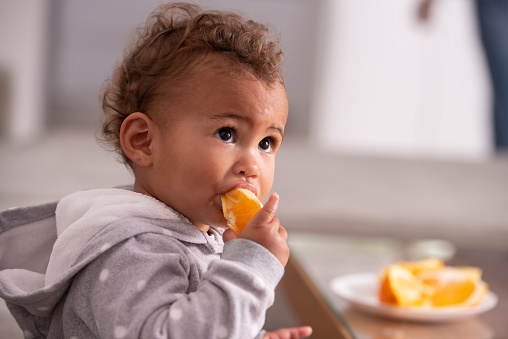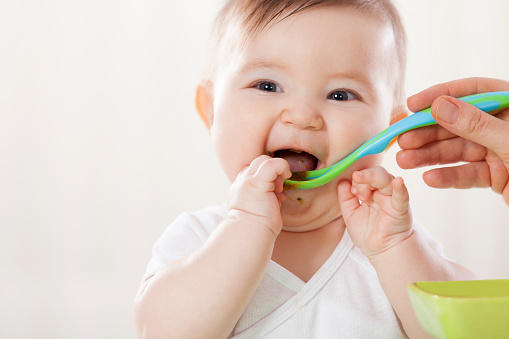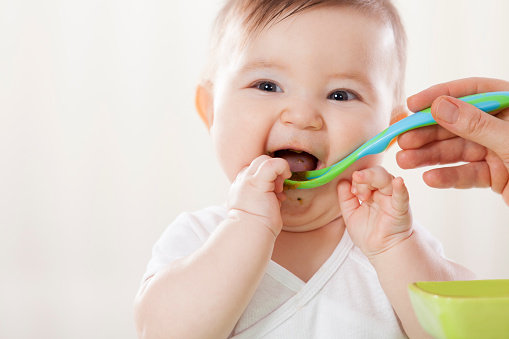When a child is around 6 months old, the American Academy of Paediatrics and the Dietary Guidelines for Americans book suggests introducing them to meals other than breast milk or infant formula. Introducing food to a baby until they are 4 months old is not advisable . Each child is different. How do you determine whether your child is old enough to eat solid foods other than breast milk or baby formula? Introducing solid foods requires research.
The American Academy of Paediatrics (AAP) recommends starting your child on solids between the ages of 4 and 6 months. But your infant will ultimately determine the best time. Others may be eager to begin eating while others may be quite willing to wait longer. Looking for indicators of eating readiness is the greatest approach to determine if your baby is ready for food.
What solid foods to offer?
 (Photo from istock.com)
(Photo from istock.com)
Offering a choice of fortified infant cereals, such as oat, barley, and multi-grain. Rather than just rice cereal, is crucial if your child eats infant cereals. Because there is a chance that children will be exposed to arsenic. The Food and Drug Administration does not advise only giving infants rice cereal. For further information, click the external icon for the U.S. Food & Drug Administration.
Introducing solid food, but how?
Start by letting your child try one food created from a single ingredient. You can use this to find out whether your child has any food-related problems, such food allergies. You should wait three to five days between each new food. Your youngster will soon be eating and savouring a variety of new meals, so don’t wait.
Foods that could cause allergies should be introduced along with other foods.
Foods containing cow’s milk, eggs, fish, shellfish, tree nuts, peanuts, wheat, soy, and sesame are among those that may cause allergies. Until your child is at least 12 months old, it is not advisable to offer them cow’s milk or fortified soy beverages. However you can introduce other cow’s milk products, like yogurt, earlier. If your child has severe eczema and/or an egg allergy, ask the doctor or nurse when and how to properly introduce foods containing peanuts.
How to prepare solid food before introducing
 (Photo from istock.com)
(Photo from istock.com)
First, meals that have been mashed, pureed, strained, or have a very smooth texture will be easier for your youngster to eat. It could take some time for your toddler to get adjusted to various food textures. Your child could cough, sneeze, or throw up. As your baby’s oral skills develop, you can start introducing meals that are thicker and lumpier.
Because some meals can be choking hazards, it’s important to provide your child food that has the right texture for his or her stage of development. To help prevent choking, prepare foods that can be easily dissolved with saliva and don’t require chewing. Encourage your infant to eat slowly by giving him or her modest meals. Whenever your child is eating, keep an eye on them.
Check out some quick recipes:
- To make cereals and mashed cooked grains smooth and simple for your infant to swallow, mix them with breast milk, formula, or water.
- Vegetables, fruits, and other foods should be mashed or pureed until smooth.
- Apples and carrots are two examples of hard fruits and vegetables that typically require cooking before being mashed or pureed.
- Food should be cooked to the point where a fork can be used to easily mash it.
- Remove all fat, skin, and bones from poultry, beef, and fish before cooking.
- Fruit should be cleaned of seeds and tough pits before being chopped into little pieces.
- Slice or cut soft foods into little pieces.
What to avoid while introducing
- Honey: If administered too early, it can lead to botulism, a deadly sickness.
- Cow’s milk (as a beverage): Breast milk and formula should continue to be your baby’s main beverages until they turn one year old. Cow’s milk can be used in cooking and baking without issue, though. Yogurt and cheese are also suitable.
- During your baby’s first year, keep them away from choking risks like popcorn, peanut butter, hot dogs, nuts, seeds, raisins, hard sweets, grapes, and raw, hard vegetables.
Manage mealtimes of the baby
 (Photo from istock.com)
(Photo from istock.com)
It can be difficult to eat meals with small children—and babies especially. You’re probably trying to make dinner when someone is sobbing, wants to be held, or needs their nappy changed. then comes the actual eating process? Let’s just say that we had no idea that a one small human could cause such a mess. Here are some suggestions to make meals a little more fun while you and your child explore the world of solids.
Introducing solid food is a slow process
It will take some time for your baby to become used to the new feelings that come with eating, such as how a spoon feels in their mouth and how different foods taste and feel. As the co-author of Food Fights, Laura Jana, M.D., assures parents, “You might get grimaces and horrible faces.” “When I placed a spoonful of food in my daughter’s mouth, she used to scream. But she yearned for more.
Introducing food variety
Starting solids is a fantastic time to offer a range of meals, including veggies, seafood, and even spicy dishes, as most new-borns like sampling new things. Early exposure to a wide variety of flavours and textures can help reduce pickiness later on.
Always be careful of allergies
 (Photo from istock.com)
(Photo from istock.com)
Give your child only one new meal at a time, and wait three to four days before introducing another, if your paediatrician has recommended it or if there is a family history of food allergies. This will facilitate quicker allergy detection.
Watch for symptoms of an allergic response or intolerance, such as a rash, hives, asthma, breathing difficulties, vomiting, excessive flatulence, diarrhoea, or blood in their stools. If you experience any of these symptoms—which can take anywhere from minutes to days to manifest—call your paediatrician immediately. If the reaction looks severe, go to the ER.
References:
Baby’s first food: How to introduce sold food
Proper nutrition for children




